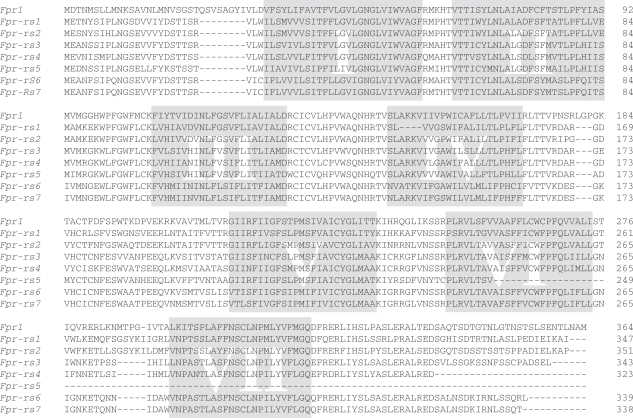Fig. 3.
Alignment of the predicted receptor sequence of the mouse Fpr genes. The putative transmembrane domains (TM-I–TM-VII) are shaded. Dashes indicate gaps in sequence created for alignment purposes. It is noteworthy that there is an eight-residue insertion in the N-terminal region of Fpr-1, just before TM-I. A three-residue insertion is found in the second extracellular loop in Fpr-1. The positively charged residues Arg84 and Lys85, found in human FPR1 and known for the interaction with fMLF, are missing from Fpr-1 and other mouse Fpr-related sequences. In its place are the noncharged residues Ser92 and Met93. The predicted Fpr-rs5 sequence is truncated at amino acid 246, resulting in a putative protein with only five TMs. Fpr-rs4 encodes a protein of 323 residues with a short C-terminal tail. In Fpr-rs1, there is a four-residue deletion in TM-IV, whereas the cloned mouse LXA4 receptor gene encodes a protein with the sequence of ARNV in its place. Polymorphisms exist in the Fpr-rs1 gene that result in amino acid substitutions at positions 3 (Thr/Ser), 8 (Pro/His), 13 (Asp/Glu), 16 (Ile/Val), 222 (Thr/Tyr), 236 (Phe/Ser), 296 (Ile/Met), and 318 (Gln/Pro) (Takano et al., 1997; Gao et al., 1998; Wang et al., 2002). The highest sequence identity (81%) is found between Fpr-rs1 and Fpr-rs2, and between Fpr-rs3 and Fpr-rs4.

